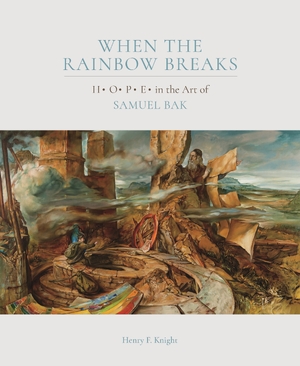Description
Common wisdom has it that a picture is worth a thousand words, but in this series of paintings artist Samuel Bak wonders: can a word be worth a thousand pictures? Words are constructed from letters, which stem from hieroglyphic representations of the world around us. The use of letters, words, and sentences in art is not the domain only of comics and cartoons. Examples exist in medieval art, in the art of the post-Impressionists, the Cubists, the Dadaists, the Conceptualists, and more. Bak has always integrated letters and words into his art, incorporating both Hebrew and English characters, cleverly visualizing turns of phrase, and playing on multiple meanings and double entendres. In this series, the letters of the word hope appear in various conditions and ambiguous states—sometimes monumental, sometimes disguised, unnaturally large or unusually small, at times solid and whole, at other times broken and in disarray. They are both impish and foreboding, sometimes clearly presented and other times defying order or even recognition. They are wounded yet resilient, detached but seeking connection.
Four simple letters—H, O, P, E—belie the significance and complexity of the word they spell. Is hope something we find or something we build? We dwell in a world that shapes us as we shape it and this interactive dimension applies to the feeling of hope, familiar to every human being who has ever anticipated, wished, or expected. For Bak, the work of building hope, or believing in the hope that others offer, requires engaging with the discarded and broken pieces of a previously trusted world now irrevocably shattered by the Holocaust. In landscapes, still lifes, and figural works, Bak gathers the layered elements of hope for us to contemplate and reminds us that they hold within and among them a promise for rebuilding and renewal. At best, hope is a wager of trust embodied in the venture of going forth.
In his essay, Henry Knight guides us through the multivalent forms of hope in Bak’s work, asks us to question what we see and look beyond the visible, endeavors to define what hope after the Holocaust looks like, and teaches us that the process of creation after destruction represented by Bak’s work is itself the ultimate act of hope.
About the Author
Artist Samuel Bak was born in 1933 in Vilna, Poland, at a crucial moment in modern history. Bak’s artistic talent was first recognized during an exhibition of his work in the Ghetto of Vilna when he was nine years old. In an artistic career of over seventy years, he has had numerous exhibitions in museums and galleries throughout Israel, Europe, and the United States and has been the subject of numerous articles, scholarly works, and books.
Dr. Henry Knight is Professor Emeritus of Holocaust and Genocide Studies and the former Director of the Cohen Center for Holocaust and Genocide Studies at Keene State College in New Hampshire. Knight is the co-chair of the biennial Steven S. Weinstein Holocaust Symposium and an ordained member of the United Methodist clergy. He is the former President of the Annual Scholars Conference on the Holocaust and the Churches and serves as a Reader/Judge for the Elie Wiesel Foundation for Humanity’s Prize in Ethics essay contest.
November 2022

